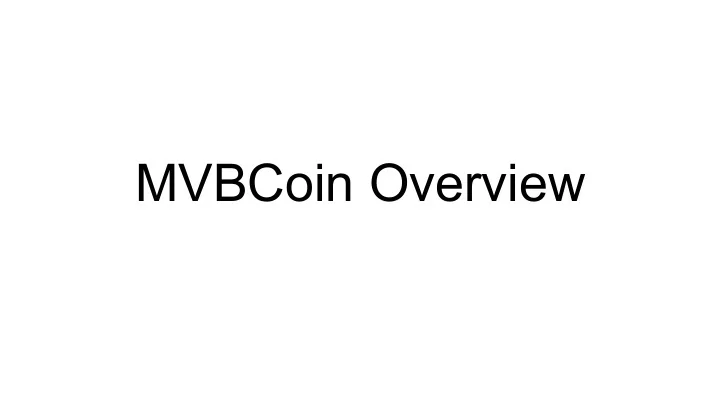

MVBCoin Overview
Tasks of an MVBCoin node ● Accept incoming connections ● Receive transactions through those connections ○ Check them for validity ○ Broadcast valid transactions to other nodes ● Collect transactions into blocks ● Mine complete blocks (by finding a valid nonce for each) ● Broadcast mined blocks to other nodes
Key components of the sample code (Go) ● Accept incoming connections -- main() ● Receive transactions through those connections -- handleIncomingConnection() ○ Broadcast valid transactions -- broadcaster() ● Collect transactions into blocks -- mineManager() ● Mine complete blocks -- mine() ● Broadcast mined blocks -- broadcaster()
Key components of the sample code (Java) ● Accept incoming connections -- Main ● Receive transactions through those connections -- IncomingConnectionHandler ○ Broadcast valid transactions -- Broadcaster ● Collect transactions into blocks -- MineManager ● Mine complete blocks -- Miner ● Broadcast mined blocks -- Broadcaster
Accepting Incoming Connections ( Main ) ● Open a socket to listen for incoming connections (100 / 187) ○ Sockets are an OS construct that manages network connections for us, with an interface similar to a file. ● Call accept() to see if we received a connection (128 / 220) ○ If there was a connection, accept() will return a new socket managing that specific connection. ○ Start IncomingConnectionHandler to read messages sent to us through this socket. ● Note: Main also has logic for initialization and shutdown.
Transaction Messages ‘0’ Sender Receiver Amount Timestamp Before processing, we must answer: ● Have we seen this transaction already? ● Do we know the sender and receiver? ● Does the sender have enough money to pay for this transaction?
Receiving Transactions ( IncomingConnectionHandler ) ● MVBCoin nodes support four message types ● First step is to read the first byte of a message - this will tell us which message type we are dealing with (189, 344) ● Then, we read in the rest of the message and process it. ○ Transaction messages - first byte is ‘ 0 ’ (192-208, 347-360) ○ Shutdown messages - first byte is ‘ 1 ’ (211-220, 363-367) ○ Block messages - first byte is ‘ 2 ’ (223-248, 369-395) ○ get_block messages - first byte is ‘ 3 ’ (251-272, 399-412) ● Once message is processed, read in next message
Receiving Transactions (cont.) ● After reading in the entire Transaction message, we call handleTransaction() . (208, 360) ● TODO : First, check to make sure this is the first time we’ve seen this transaction (282, 430) ● Then, we parse the transaction (284-290, 432-440) ● TODO: check if the sender and receiver are valid and if the sender has enough money, then transfer the funds (294, 442) ● If the transaction is valid, broadcast it and pass it over to MineManager to add it to the next block (296-300, 444-447)
Collecting Transactions into Blocks ( MineManager ) ● Receive a new transaction (340, 542) ● Add the transaction to our current block (347, 591) ● Check if we completed a block (349, 593). If we did: ○ Create space for the next block of transactions (350, 594) ○ If not currently mining, start mining by: ■ Add metadata to the current block, such as the block height, our node ID, previous hash (323-328, 510-514) ■ Start Miner (330, 516-517) ○ Can’t start mining if already mining (it’s a block chain )
Mining a block Prior Block Miner Nonce TX TX TX TX Height Addr Hash SHA256 00 00 00 00 ba 78 16 bf 8f 01 cf ea 41 41 40 de 5d ae 22 23 b0 03 61 a3 96 17 7a 9c b4 10 ff 61 If at least difficulty bytes are null, this was a valid nonce.
Mining ( Miner ) ● TODO : write this function ● The goal of this function is to repeatedly run: sha256.sum([NONCE]+[PRIOR_HASH]+[BLOCKHEIGHT]+[MINER_ADDR]+BLOCKDATA) ○ Note: MineManager already built this string for us. ● Each time, try a different value for [NONCE] ● Check how many initial bytes are zero ○ If at least difficulty initial bytes are zero, we found a valid nonce! Return this nonce to MineManager .
Generating the Block Message ( MineManager ) ● Receive a new nonce (357, 542) ● Format the Block message (362-373, 557-572) ● Add the block to our list of processed blocks (377, 576-578) ● Send it to Broadcaster to send to peer nodes (380, 581) ● Check if we have any other complete blocks ready to be mined (383-384, 584-585) ○ If we do, add metadata and start mining (385, 586)
Broadcasting Messages ( Broadcaster ) ● Receive the first message to broadcast (144, 246-253) ● Open a socket to each peer (148-155, 257-268) ● Broadcast the message (158-168, 271-277) ● If the message was a close message, exit after broadcasting it (163, 278-281) ● Otherwise, wait to receive another message to broadcast (169, 283-290)
Recommend
More recommend